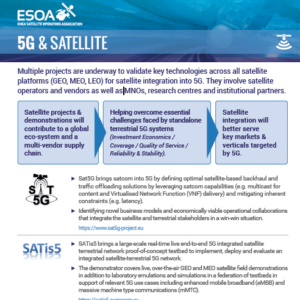The recent push for new 5G ecosystems paves the way for cooperation between two parts of the telecommunications industry, satellite and terrestrial, in order to define and specify the needs of a single 5G system from a holistic perspective. Satellite communications can address some of the potential challenges for terrestrial networks and support the different requirements, especially related to cyber-resilience, for 5G networks.
Satellites can provide the wide coverage to complement and to extend the terrestrial network, to enable the ubiquitous coverage targeted by 5G networks. They can provide larger cells in a heterogeneous arrangement than terrestrial networks, which can also be used for critical and emergency services and relieve terrestrial cells of signalling and management functions in a software defined network configuration. Integration of satellite with terrestrial systems is key to enable many advantages for users. One of these is improving Quality of Experience by intelligently routing traffic between the delivery systems and caching high capacity video for onward transmission terrestrially. This can be empowered by the multicast/broadcast capabilities of satellite systems (hybrid networks), while latency is no longer an issue thanks to intelligent caching. Furthermore, traffic can be offloaded from the terrestrial system to save on valuable terrestrial spectrum, thus opening up the possibility of improving resilience and security using the two networks.
Space-based satellites have an important role to play in supporting overall resilience by complementing other communications infrastructures and by being less vulnerable to cyber-attacks. Satellites can support a resilient 5G network to mitigate the problems of over-load/congestion to meet the 5G goal to ensure access to a wider portfolio of services and applications at lower cost for everyone, everywhere.




